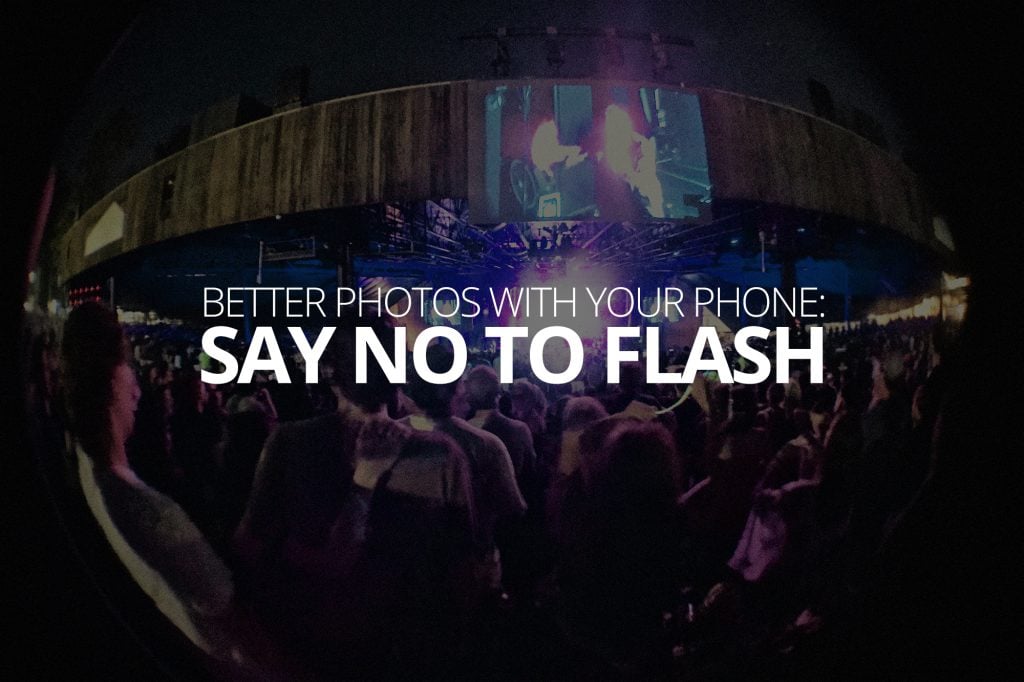Welcome back to Better Photos with Your Phone. The last few weeks we’ve been oscillating between practical advice and advice centered more around mindsets and thought processes. This week, we’re back with something very practical, and it deals with some of the most impossible photo moments. Those moments where you want to take a photo, but there isn’t enough light to get a good one.
Now, you may be ahead of me here in pointing out that your phone has a little light on it and when it’s too dark, the light comes on. That little light is called the flash, and lets be perfectly clear in saying it really sucks, and almost always looks like crap.
Let me take a moment to explain what’s going on without getting bogged down in technicalities. First, it’s important to understand that as a general rule of thumb, if it’s dark, the photo you take will probably be ‘blurry’. That’s because when there’s not enough light, you have to hold the camera more steady, and whatever you’re trying to take a picture of also has to stay more still. Second, when there isn’t enough light, the camera captures a much more ’noisy’ or ‘grainy’ image, so if the thing you’re taking a picture of is far enough away, the details are going to be lost under all the grain and noise and the result looks blurry. The built in light on your phone tries to resolve both of these problems, but usually with some unsatisfying trade-offs.
Although a picture taken with the phone’s flash will be less grainy or noisy than one taken with lots of natural light, the flash generally looks unflattering on the skin, flattens out faces, and sometimes even creates a kind of sickly look because the color of the flash and the color of the natural light in the environment are usually very different. And to make matters worse, because of the position of the phone’s flash it eliminates natural contours and shadows thereby highlighting imperfections on skin, rather than obscuring them with the kind of natural looking light we’re all used to seeing in real life.
If you’d like to test out this trade-off for yourself, go into your bathroom or kitchen and take a photo of the baseboards. Then turn the phone’s light on and do it again. The photo that is illuminated with the flash is going to suddenly make the baseboards look really dirty. Well, that’s because they probably are dirtier than you think, it’s just that the natural light and contours in the baseboard make it easier not to notice. The same sort of thing happens when using the phone’s light on someone’s face. Blemishes are no longer hiding behind the way natural light plays with facial features.
Perhaps the biggest reason to say no to the phone’s flash though is how rarely it’s really the best tool for making a photo look better. The phone’s flash is extremely limited in its range, meaning if the thing you’re trying to take a photo of is more than 5 or 6 feet away, the light isn’t going to be powerful enough to really meaningfully improve the photo. Of course, your phone doesn’t know that, and it’ll try and use your flash whether the thing you’re taking a picture of is 4 feet away or 40 feet away. That means if you don’t stop and think about it, and just let the camera decide what to do, almost every photo you take in low light is going to look like junk.
But, it doesn’t have to be that way, you just need to understand the trade-offs and when it makes sense to make them. That starts with understanding why you’re taking the photo in the first place.
Why are you taking the photo
The flash on your phone is not useless. It makes a great flashlight! It’s also perfect for taking a photo of an empty spice jar you need to replace at the grocery store, or the VIN number on your car when a late night phone call with your insurance company calls for it. In short, the phone’s flash is perfect for purely utilitarian photos.
It’s also useful in situations where there really is no other option (though there usually is, and I’ll get to that next).
It starts with deciding if the photo you’re about to take is something you’ll want to enjoy coming back to many years from now, or something you just need to solve a problem right now. If you’re intention is the former, it’s probably best to make the trade-off, and give up some detail in the photo in favor of the scene appearing more natural to your eye.
How to not use the flash
As I mentioned, there are some situations, even those involving people, where the flash is the only real option. But those instances are rare. In almost every case, try doing one of the following instead of using the flash, and your photos will look better, in general.
Find any natural light. By natural light, I mean light that already exists in the environment, not necessarily light from the sun which is obviously not possible after dark. Just about any light the environment has to offer will do. The light coming from the bar, or the light from a restaurant’s sign, or even the light coming from the hallway to the bathroom might do. This calls back to the lesson in week #3. Before taking a photo, take the breath and decide if there’s a better place, time, or context for the photo you want to take. In this case, perhaps not around the dimly lit table, but instead near the aquarium putting out lots of light. If moving around is an option, then this is almost always going to work. Just remember, the dimmer the light is, the closer to the light source you need to get for it to help.
Set the phone down and use the built in timer. All modern phones have a delayed timer for taking the picture. That means you could prop the camera up on a table and take the photo without even having to hold the phone. If you recall, photos without enough light are usually blurry, in part, because you have to hold the camera more still. Well, you don’t get more still than an inanimate object holding it for you. The photo will still be grainy, but should be much more clear and in most cases everyone will at least be looking natural and true to how they actually look in that environment.
Accept the technical imperfections to preserve the best memory. As I mentioned earlier, the phone’s flash can wreak havoc on a person’s appearance by highlighting blemishes and imperfections. The nostalgic result is disappointing because rather than remembering the time you enjoyed, you’ll instead remember incidental human imperfections that no one really noticed at the time. A grainy or even blurry photo of you and your mom that helps you remember good times together and the special relationship you shared is much, much better than a ‘clearer’ image that just causes you to remember how bad your acne used to be. So, dimly lit photos, grainy photos, even blurry photos, in hindsight, are often preferable to those with more details (that you’d rather not see).
Just don’t take the photo. This one might seem a little like cheating or antithetical to the very purpose of this blog series, but it’s not. It’s just true. Sometimes it’s really just too dark, what you want to take a picture of is too far away, and exercising some control over the situation to take a photo is just too much of a hassle. Nothing you do is going to make a photo of a friendly ball game just after dusk come out well. If your kid is in a stage play and the lights are too low, you’re out of luck. Speaking as a professional photographer who is generally equipped to capture something worthwhile in most conditions, sometimes it’s best to just not take the photo at all.
When you should use the flash
So, as I think I’ve explained clearly enough, it’s almost always a bad idea to use the flash when people are your subject. But there are occasions.
For example, perhaps you’re with someone who is only in town for a few hours, you’re together to watch a concert and there is no opportunity to go and find some natural light. It’s probably better to have that photo—even if it looks bad—than to not have it at all. In that case, make sure the camera is within a few feet and go ahead and use that flash.
That’s about it. When people are the subject, the flash should absolutely be a last resort. Try to keep the flash off all the time, until there’s a moment you know can’t be replicated, diverted, rearranged, and in which there is a coming together of great importance to you. Or when the photo you’re taking has a clear and limited purpose, such as remembering the brand on an empty spice jar. Just keep in mind, if the thing you’re taking a photo of is more than 4-5 feet away, the flash is almost always going to make it worse. So, never use a flash at a ball game, concert, or really any big open space, and use it only when you’ve deliberately decided to.
Don’t let the camera decide for you.
Next Time
We’ll be getting a little bit technical as we try to tackle those tricky lighting situations, such as when all the light is coming from behind your subject and when the brightest parts of the scene are also the least important.
I hope you’ll be following along!

